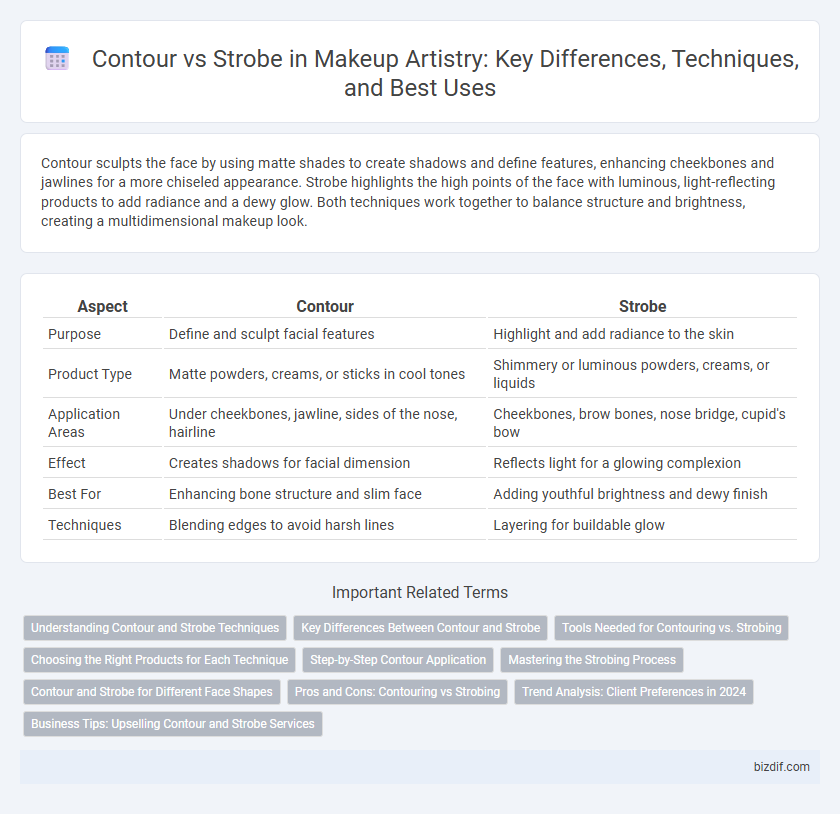Contour sculpts the face by using matte shades to create shadows and define features, enhancing cheekbones and jawlines for a more chiseled appearance. Strobe highlights the high points of the face with luminous, light-reflecting products to add radiance and a dewy glow. Both techniques work together to balance structure and brightness, creating a multidimensional makeup look.
Table of Comparison
| Aspect | Contour | Strobe |
|---|---|---|
| Purpose | Define and sculpt facial features | Highlight and add radiance to the skin |
| Product Type | Matte powders, creams, or sticks in cool tones | Shimmery or luminous powders, creams, or liquids |
| Application Areas | Under cheekbones, jawline, sides of the nose, hairline | Cheekbones, brow bones, nose bridge, cupid's bow |
| Effect | Creates shadows for facial dimension | Reflects light for a glowing complexion |
| Best For | Enhancing bone structure and slim face | Adding youthful brightness and dewy finish |
| Techniques | Blending edges to avoid harsh lines | Layering for buildable glow |
Understanding Contour and Strobe Techniques
Contour techniques use darker shades to create shadows that define and sculpt facial features, enhancing cheekbones, jawlines, and nose shapes. Strobe techniques employ lighter, shimmering products to highlight and bring forward high points of the face such as the cheekbones, brow bones, and cupid's bow for a radiant, glowing effect. Mastering the balance between contour and strobe enhances facial dimension and creates a harmonious makeup look.
Key Differences Between Contour and Strobe
Contour and strobe techniques enhance facial features by manipulating light and shadow, but contour uses darker shades to create depth and sculpt structure, while strobe applies lighter, reflective powders or creams to highlight and brighten specific areas. Contouring primarily targets hollows like the cheekbones, jawline, and sides of the nose, making features appear slimmer and more defined. Strobing focuses on the high points of the face such as the cheekbones, brow bones, and the bridge of the nose, enhancing a radiant, dewy finish.
Tools Needed for Contouring vs. Strobing
Contour requires tools such as matte contour powders or creams, angled brushes, and blending sponges to sculpt and define facial features with shadows. Strobing utilizes shimmery highlighters, fan brushes, or fingertips to enhance the high points of the face by reflecting light. Choosing the right tools ensures precise application and flawless blending for both contouring and strobing techniques.
Choosing the Right Products for Each Technique
Contour requires matte, cool-toned powders or creams designed to create shadows and define facial features, while strobe depends on luminous, light-reflecting highlighters that enhance the high points of the face for a radiant glow. Selecting contour products with blendable formulas and buildable pigmentation ensures natural-looking depth, whereas strobing products should offer a smooth texture and varying intensity levels for customizable shine. Prioritize long-wear, skin-friendly ingredients in both techniques to achieve a flawless finish suitable for different skin types and occasions.
Step-by-Step Contour Application
Step-by-step contour application begins with selecting a contour shade two to three tones darker than the natural skin tone to create natural shadows that define facial features. Using a contour brush or makeup sponge, apply the product along the hollows of the cheeks, sides of the nose, jawline, and hairline, blending thoroughly to avoid harsh lines. Highlighting follows next to enhance these contours, emphasizing the cheekbones and brow bones for a sculpted, dimensional makeup look.
Mastering the Strobing Process
Mastering the strobing process in makeup artistry emphasizes highlighting specific areas of the face such as cheekbones, brow bones, and the bridge of the nose to create a radiant, glowing complexion. Unlike contouring, which uses darker shades to sculpt and define facial structure, strobing relies on light-reflecting products like highlighters to enhance natural features and add luminosity. Proper application techniques involve blending highlighter seamlessly with foundation and setting spray to achieve a dewy, fresh finish that enhances skin texture and dimension.
Contour and Strobe for Different Face Shapes
Contour sculpts and defines facial features by using matte shades to create shadows, enhancing the natural bone structure of oval, round, or square face shapes. Strobing highlights the high points of the face, such as cheekbones, brow bones, and the bridge of the nose, using luminous, shimmery products to create a radiant, lifted effect suited for heart-shaped and long faces. Combining contour and strobe techniques tailored to specific face shapes enhances dimensionality and brings balance to facial proportions.
Pros and Cons: Contouring vs Strobing
Contour sculpts the face by creating shadows that define cheekbones and jawlines, offering a polished, structured look ideal for photography and formal events. Strobing highlights the high points of the face, providing a radiant, youthful glow that enhances natural features without heavy makeup. While contouring requires skill to blend seamlessly and avoid harsh lines, strobing is quicker and more forgiving, though it may not provide the same depth or dimension.
Trend Analysis: Client Preferences in 2024
2024 client preferences reveal a growing shift towards strobe makeup for its natural glow and skin-enhancing effects, favored especially among younger demographics seeking a radiant, dewy finish. Contouring remains popular in professional and editorial makeup, with demand for sculpted, defined facial features persisting among clients aiming for dramatic transformations. Market analysis indicates an increase in hybrid techniques combining subtle contouring with strategic strobing to meet evolving beauty trends prioritizing both structure and luminosity.
Business Tips: Upselling Contour and Strobe Services
Offering both contour and strobe services enhances client satisfaction by addressing diverse skin tones and lighting preferences, increasing upsell opportunities. Highlight the benefits of contouring for defining facial features alongside strobing's ability to create a radiant, dewy glow to encourage package deals. Leveraging before-and-after photos and educating clients on tailored application techniques boosts perceived value, driving higher revenue per appointment.
Contour vs Strobe Infographic

 bizdif.com
bizdif.com